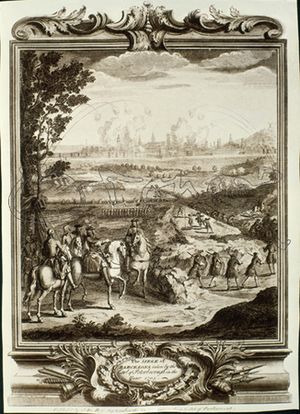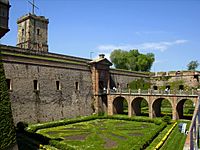Siege of Barcelona (1705) facts for kids
Quick facts for kids Siege of Barcelona |
|||||||
|---|---|---|---|---|---|---|---|
| Part of War of the Spanish Succession | |||||||
 Lord Peterborough overseeing the siege of Barcelona |
|||||||
|
|||||||
| Belligerents | |||||||
| Commanders and leaders | |||||||
| Strength | |||||||
|
5,800 5,000 infantry 800 cavalry |
11,000 8,000 regulars 3,000 militia 52 ships 40 heavy siege guns |
||||||
| Casualties and losses | |||||||
| Entire garrison captured | Unknown | ||||||
The Siege of Barcelona happened between September 14 and October 19, 1705. It was a major event during the War of the Spanish Succession. During this siege, a large army called the Grand Alliance captured the city of Barcelona. This army was led by Lord Peterborough. They supported Archduke Charles who wanted to be the king of Spain. The city was defended by soldiers loyal to Philip V, who was the other person claiming the Spanish throne. After the city was captured, most of Philip V's soldiers joined the Grand Alliance army.
A year before, an attempt to land troops in Barcelona had failed. After Lord Peterborough captured the city, Philip V's forces tried to take it back in 1706, but they also failed. Barcelona and the region of Catalonia stayed under the control of the Grand Alliance until Philip V's forces finally took them back in 1714.
Contents
Why Barcelona Was Attacked
After the War of the Spanish Succession began, the region of Catalonia was seen as a good place for the Grand Alliance to start their fight. They wanted to put Archduke Charles on the Spanish throne. This was against Philip V, who was supported by France.
Prince George of Hesse-Darmstadt, who used to be the governor of Catalonia, suggested attacking Barcelona. In 1704, he had tried to land troops near the city but had to leave. However, he still believed that the people of Catalonia would welcome the Grand Alliance. This was because they were unhappy with the government in Madrid. The government had been very strict with them.
The Grand Alliance had already captured Gibraltar. They then started looking for other places to use as bases. In 1705, a new group of ships and soldiers, mostly from England and the Netherlands, sailed from Lisbon. The French commander in Spain, the Duke of Berwick, was worried about an attack on Barcelona. He asked for 12,000 French soldiers to be sent south, but his request was not granted. The governor of Barcelona thought the Grand Alliance would attack Nice instead.
The leaders of the Grand Alliance expedition had orders to choose between several places, including Cadiz and the French naval base at Toulon. But they decided to try to capture Barcelona again. Queen Anne of England promised to protect the traditional freedoms of the Catalan people.
The Landing of Troops
The expedition was led by the English General Lord Peterborough. His second-in-command was James Stanhope. Prince George of Hesse-Darmstadt and Archduke Charles also came with them. The fleet, commanded by Sir Cloudesley Shovell, arrived near Barcelona on August 16.
The city's defenses had recently been fixed and made stronger. Steps were also taken to make sure the people of Catalonia would not rise up to support the Grand Alliance. Lord Peterborough had been told that he could count on help from Catalan citizen soldiers, called militia, who were gathered by the Count of Cifuentes.
On August 23, the Grand Alliance troops landed three miles east of Barcelona. Local people gave them a warm welcome. Both Archduke Charles and Lord Peterborough made public announcements. After the landing, several thousand Catalan rebels gathered outside the city. They flew the Austrian flag, showing their support for Archduke Charles. They blocked Barcelona to stop any supplies from getting in. Some cannons were set up under the command of Colonel John Richards, an engineer. Archduke Charles at first did not want to bomb the city. He worried it would upset the people he hoped would become his subjects.
Fighting for the High Ground

After the first landing, not much happened for several weeks. Lord Peterborough was concerned that he did not have enough soldiers. The city's defenders were many. He thought about giving up the siege and moving his army to Italy. However, in meetings with his officers, called a council of war, Admiral Shovell and many of his generals disagreed. They wanted to attack.
A very important target for the Grand Alliance was the strong fort of Montjuïc. This was a large hill that looked over the city. In September, Lord Peterborough agreed to attack it. To keep the plan a secret, he pretended that his army was leaving the siege. He made it look like they were marching away towards Tarragona to the south.
A British attack force, led by William Southwell, was prepared. A backup force, led by General Stanhope, was ready to follow. Even though Prince George did not have a formal command, he went with the attack force. He wanted to help and show them the way.
The attack faced more resistance than expected. Prince George was hit in the leg by a musket ball. This wound was deadly. The loss of Prince George made the attacking soldiers lose their courage.
The hill was eventually captured in September during the Battle of Montjuïc.
Images for kids
See also
 In Spanish: Sitio de Barcelona (1705) para niños
In Spanish: Sitio de Barcelona (1705) para niños



